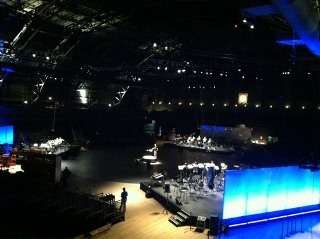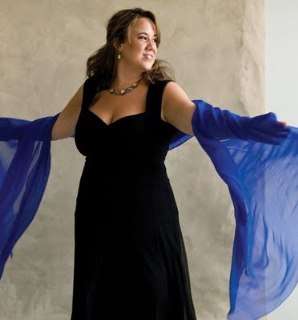|
Back
Expanding and Fusing Time and Space New York
Park Avenue Armory
06/29/2012 - & June 30, 2012
Giovanni Gabrielli: Antiphon
Pierre Boulez: Rituel in memoriam Bruno Maderna for Orchestra in Eight Groups
Wolfgang Amadeus Mozart: Don Giovanni, K. 527: Finale to Act I
Karlheinz Stockhausen: Gruppen for Three Orchestras
Charles Ives: The Unanswered Question
Ryan McKinny (Don Giovanni), Keith Miller (Leporello), Julianna Di Giacomo (Donna Anna), Russell Thomas (Don Ottavio), Keri Alkema (Donna Elvira), Sasha Cooke (Zerlina), Kelly Markgraf (Masetto), Brian T. Scott (Dancer: Waiter)
Oratorio Society of New York, Manhattan School of Music Chamber Choir, Kent Tritle (Director), Ronnie Oliver, Jr. (Assistant Director), Gareth Morell (Rehearsal Pianist and Musical Consultant), Joshua Weilerstein (Assistant Conductor), New York Philharmonic Orchestra, Alan Gilbert, Magnus Lindberg, Matthias Pintscher (Conductors)
Michael Counts (Director and Designer), Fisher Dachs Associates (Theatre Design), Ken Roth (Choreographer), Brian Aldous, Kyle Chepulis (Lighting Designers), Kaye Voyce (Costume Designer)

Rehearsal at Armory (© New York Philharmonic)
A century ago, musical space was intended to be filled. A small stage was for the recital a large one for orchestras. An amphitheater, needed a chorus to shake the heavens or a symphony of a thousand. But (thank you, Mr. Einstein), these days we understand space to be a virtually organic dimension in itself. The lucre. the talent and the audience has the possibility for a nocturnal adventure.
The New York Armory, no longer enlisting troups to fight Johnny Reb, is used for productions extravagant and subtle, custom made for Homeric battles and eccentric enough for the most eccentric artists.
Last night (and tonight), the New York Philharmonic used its space for good and evil, presenting five amazing pieces of music which–not always happily–fit the hall. Alan Gilbert rightly enlisted his New York Philharmonic to play in unusual ensembles spread across the hall. But with enterprise which only a New York conductor could achieve, he also enlisted two of today’s most prominent and interesting composers to leave their quills and manuscripts and raise their batons and eyes to their orchestras.
Needless to say, the seats of the armory–placed in the center and on three rows of bleachers going up to the ceiling–were filled. The shape of the building, resembling European train stations built in the 1880’s might look like a wasteland without an event, but last night, the place resembled something from Last Year at Marienbad.
On three sides, platforms were built to hold full orchestras (or, in the Boulez work three or four little orchestras). In the center of the audience was a round dais which would be used for the opera.
All of this was surrounded by the audience. And while only owls could get a 360-degree visual or aural view, our choices were benefits in themselves.
Conductor Alan Gilbert began with an appropriate “easy” piece–an antiphonal for brass by Giovanni Gabrielli, its resonances and faultless playing by the Phil from every corner echoing the sounds of Venice’s St. Mark’s Cathedral.
That, though, was simply to “soften” the audience for the next work, Pierre Boulez’ Rituel for eight orchestras in memory of his colleague Bruno Maderna. The forces were extraordinary–eight orchestras of various sizes, from two clarinet to a full small orchestra–but it needed only a single conductor, since each orchestra had a percussion player who led its own group.
The result was very very special. I had heard Rituel once on recording. But here, listening to the subtle sounds from every side of the Armory, one witnessed a very Japanese ceremony. That was because the percussion was mainly of the woodblock variety. Specifically, temple blocks, log drums, wood blocks, small gongs, tom-toms, hand-drums etc etc. And while the orchestras rose up in wailing or blasts of brass, that was rare.
Mainly, this was the funeral ceremony of a wooden Japanese temple. Not the resonances of Saint Marks but the secret sounds, the tiny echoes within echoes, the soft cracks and taps that signaled across the vast spaces, like nature, branches cracking on an empty landscape. It was space that lived, not the creatures within space.

J. Di Giacomo (© Dario Acosta)
I seriously hesitate speaking of the next piece, the only misconstrued effort of the evening.
Mozart always desired larger stages for his grandest operas, but a 55,000-square-foot arena would hardly have been in his dreams. Yes, the last scene of Act One employs one house orchestra, two “stage” orchestras, dancers, lovers, rivals, servants and supernumeraries. But librettist Lorenzo Da Ponte and Mozart were so consummate, so pointed in action and music that this bewildering confusion of actions would not have amused them.
It was a spread-out mess around the audience and around the orchestral stages. Women with wigs circumscribed the audience, men with faintly modern dress met them, and they would dance a few steps. The lead characters would run to the middle dais, sing a few bars, run down, then run up again with a sword and run down again.
Voices sung to each other from different areas of the Armory, and while the music was in sync–the main orchestra and the dance orchestras used for this banquet scene–nothing connected.
One could picture this ensemble like a Masque by Lully for the delight of Louis XIV, with enough dancers, singers and orchestras to eschew any meaning. But neither Mozart nor Da Ponte ever deigned to write this kind of outdoor entertainment.
Yes, the concept was unusual. Then again, so was Woody Allen’s description of his failure as an avant-garde opera director who had staged Rigoletto with white mice. Last night, Da Ponte would have been outraged (if faintly amused) that his words were lost. Mozart would have been confused.

M. Lindberg, NY Phil, A. Gilbert (© New York Philharmonic)
The audience had come to hear Stokhausen’s Gruppen, almost never performed for good reason. Not only do we need three full orchestras, but three very sharp conductors.
Not that Stockhausen had written this to show off space. Quite the opposite. He had simply conceived a work with so many different time signatures, meters, pulses, rhythms and tempi that a single orchestra wouldn’t be able to do it.
Thus, out of necessity, we had three orchestras. And these three Phils–conducted by Alan Gilbert and two sterling conductor/composers, Magnus Lindberg and Matthias Pintscher–did astounding honors.
But could they do more than beat time? Especially since there were about 40 different times to beat for each ensemble? Not only did they do this, but Mr. Gilbert (whose orchestra was on my side of the auditorium), gave enough physical signals for each section that one would have thought he was conducting A Little Night Music.
It is, at any rate, Herculean music, even at its softest. Ignoring the “explanations” of pulse tone-rows and transformations etc, it is a sound palette which cannot help but grab the most troglodytic listener. There were times when the percussion rolled around from one ensemble to another, an almost sacred merging of brasses towards the end. It was a 25-minute spectacle without a single solitary second without auditory interest.
The finale was not what Charles Ives had written–but he would have loved it. For he loved spectacles as much as songs, he loved the outrageous as much as the intricate. The Unanswered Question was written for small orchestra, a medley of flutes and an offstage trumpet. The small orchestra was morphed into three string orchestras (and the three conductors), the flutes were in the center (with another conductor), and our trumpet player, Philip Smith, was almost literally in heaven. That is, at the top of the Armory, his faint notes like echoes of the Transcendental.
One wondered at first why this chamber music would have ended such a grandiose evening. But then, everything which Ives wrote instinctively, extravagant, grandiose and outrageous.
It took an Alan Gilbert to understand that physical space need not be filled. That space can be filled with notes...or spaces...or emptiness or fullness...for or the quantum achievement when time and space are fused as one.
Harry Rolnick
|